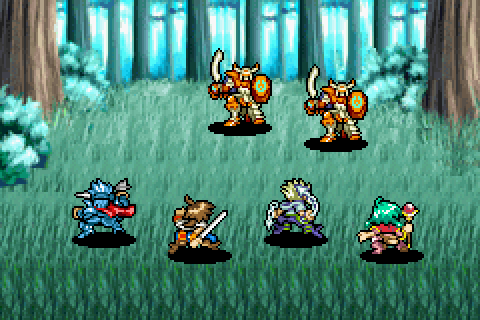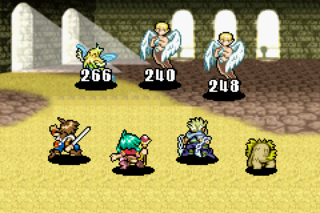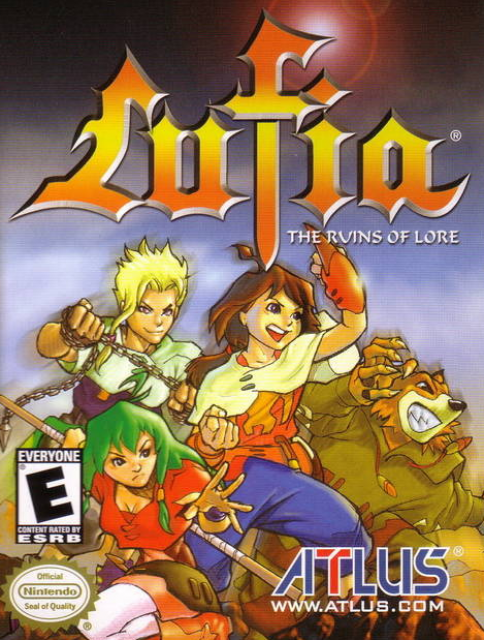A different Beast – Lufia: The Ruins of Lore review
(Alternate title: Eldin haz a :D)
When you have a series that has been built around each installment having essentially the same plot each time, what happens when you get an installment that's all about being a completely different story?
Lufia: The Ruins of Lore is the black sheep of the Lufia franchise. There are no Sinistrals to be found here, no red-haired swordsman hero, no blue-haired female companion. It's not entirely detached from the series, taking a great deal of influence from the most popular game of the series, Lufia II: Rise of the Sinistrals, but it's still quite different in feel from the rest of the series. Yet even without many of the iconic elements of the Lufia series and quite a few new elements, Ruins of Lore still remains a solid RPG experience and a pleasant twist on the Lufia formula, despite a few hiccups along the way.
The Story & Characters
As mentioned previously, Ruins of Lore abandons the series's tradition of red-haired heroes gathering allies to fight the four evil Sinistrals. Instead, Ruins of Lore's plot revolves around an evil empire seeking to use an ancient evil known as the "Beast" to take over the world.
Your opinions may vary on which plot is more generic.
Unusually for the series, the main character Eldin (whose name and even colour scheme can be customized) is a silent protagonist. His "responses" consist solely of effects on his field sprite and his portrait. No age is specified for the main characters, though Eldin looks like he's eight years old.

The two other main characters, Torma and Rami, are simple characters. Torma's your hot-headed sidekick and Rami's the softer wingwoman. They're fine. The priestess Rubius has an interesting arc and the half-monster Bau has some good interactions with other characters.
There is one character who's miles above the rest of the cast though, and is likely one of the biggest attractions of the game. That would be the legendary warrior Dekar, perhaps the most famous of Lufia II's party members. With age has come...well, not that much wisdom. We are talking about Dekar here. He's still the idiotic badass we came to love just as much as he loves swords, with some nice nuance to his character.

All in all, while the story doesn't quite have the same charm as previous entries in the series, it's still a nice and simple plot without any notable flaws.
The Dungeons
One of Lufia II's defining elements were its dungeons that featured various puzzles that the player had to complete in order to progress or obtain bonus loot. Whereas Lufia: The Legend Returns went in a much different direction with its randomly-generated dungeons, Ruins of Lore goes for what can best be described as "Lufia II lite". There's still puzzles, though far less in number than Lufia II. While most are quite simple, there's a few that are quite tricky to figure out. Eldin, Torma, Rami, and Bau each have their own ability to overcome obstacles, while Rubius has the ability to read ancient languages in dungeons.

Dungeons are also more maze-like. There are times where it's easy to get lost or miss passages, but it does lead to dungeons that are fun to explore. Instead of an overworld which your characters travel through, routes between destinations function the same as dungeons and destinations you've already reached can be accessed instantly from the world map. It works quite well.
The Ancient Cave, one of the most famous aspects of the Lufia series, is completely changed from the prior games. Instead of being a hundred-floor romp where your party is reduced to Level 1, there's only sixty floors and only Eldin and his disc monster can enter with a limited number of additional items though they remain at normal levels. Veterans of the series might be disappointed with the changes, but it is much more accessible and much less intimidating.
The Battle Systems
Encounters function the same as in the previous two games, in which the direction that your character and the enemy are facing when they touch influences whether one side will ambush the other or not. A notable immediate absence is the ability to freeze enemies in the field; though you can eventually get an ability to do this, it's easy to miss and a hassle to use. The battle system also takes the speed system from Lufia & The Fortress of Doom, where higher-agility characters get their turns more often than lower-agility characters. (It's similar to Final Fantasy X's Conditional Time Battle system.)

There's two notable added systems in Ruins of Lore. The first is the job system, where the three main characters can take jobs that affect their stats and determine which abilities they learn as they battle. It's not a very deep system—it doesn't affect equipment options, ability growth is solely linear, and Rami is going to hit for nothing whether she's a Wizard or a Swordsman—but there's no real flaws to it either and allows your three main characters to learn a good variety of skills.
The other major system is the disc monster system, where encountered monsters can be captured using discs to fight alongside your party members. Each of the three main characters can have one monster with them in the party, which you can swap out for other party members and even their own keepers outside and inside of battle. Monsters level with your party, gaining levels and new abilities. You can have monsters learn abilities from other monsters, though this consumes the monster providing the ability. Monsters act on their own in combat and, unlike the human characters, vanish when defeated (allowing another character to take their place) and automatically revive after battle. Monsters also play into Ruins of Lore's Installation system, where the three main characters can fuse with a mature-enough monster once their IP meter is full. For the three-turn duration, the fused characters are invulnerable and will repeat the same ability each turn. Installation's usefulness varies between monsters, though I've personally never really used Installation except in early battles.
Both systems do suffer from a "problem", though how much of a problem it is depends on the player: balance. Some abilities are just plain overpowered. The job system allows your characters to learn Frost (a base-level Wizard spell that hits all enemies for 8AP) and Slash All (a Swordsman technique that strikes all enemies for 3AP...or you can have them learn the Rogue ability Rapidfire, which a.) strikes all enemies, b.) raises the user's agility with each use, and c.) costs absolutely nothing to use. There's other overpowered abilities, such as Chance Hit which does between 20 and 200 damage in intervals of 20 and can be learned long before your characters are doing 30 damage with a standard attack. Likewise, monsters can be taught powerful and cheap abilities such as the aforementioned Rapidfire or the all-hitting Octo Strike.

Note that these two systems only apply for the three main characters; Bau and Dekar can't get jobs or capture monsters. While having a few characters without access to skills isn't a bad thing, Bau and Dekar still have an IP meter which they can never use. Which is just odd.
Conclusion
Ruins of Lore...doesn't quite have the same magic as Lufia II. It's quite a different beast (hahah) from the entirely of the series in terms of plot, though it takes gameplay elements from various games in the series. That doesn't mean it's a bad game; I certainly enjoyed what Ruins of Lore had to offer, both from a pure gameplay perspective and the nostalgic factor. This adventure in the world of Lufia is definitely worth the time...even if all you want, just like I did, is more Dekar.

Tl;dr – Ruins of Lore doesn't quite have the magic of Lufia II, but makes up for it with its own charm in what it brings to the table and what it revisits from the series.
